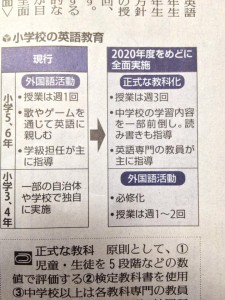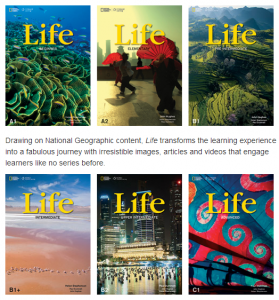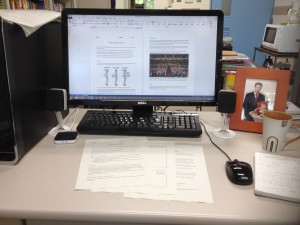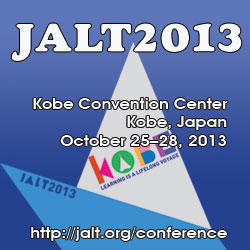Elementary School English (MEXT announcement)
Some big news from MEXT this week (courtesy of Kensaku Yoshida on Facebook)
Basically, from 2020 (estimated), 5-6 grade students will have English as a subject three times a week with specialist teachers. 3-4 grade students will have English activities once or twice a week.
The devil is in the details (see my recommendations here) but this looks like a step in the right direction!
language courses materials Review reviews textbooks
by sendaiben
leave a comment
Review: Life (4-skills series by Cengage)
After a long hiatus, a review. This textbook is for teenagers and adults.
Life is a 6-level, 4-skills series consisting of a student book, workbook, and teacher’s book at each level. The student book has a DVD with videos, and the teacher’s book contains two CDs with the class audio. The workbook also has a CD for listening-based homework. The series runs from Beginner (A1) to Advanced (C1).
First impression: Life is gorgeous. Cengage is really leveraging all those National Geographic photos they have access to, and it is working really well. If you are a Japan-based teacher you will probably be struck by how dense the book is -there is a lot on each page and much less white space than we are used to. Someone described it as a ‘European-style’ textbook, as opposed to ‘Asian-style’.
The Good
- This is a very attractive textbook. The design and production values are very high.
- There is a lot of content. Each book has 12 units, each unit has 6 sections. We’ve been working through one section per class so far.
- A really nice variety of topics and media (print. audio, video).
- There is a lot of variety. Reading, grammar, vocabulary, and speaking exercises on almost every page.
- The class audio is included in the teacher book. I like this idea a lot, rather than making us buy separate overpriced classroom CDs like many publishers do.
- The website actually seems to have useful materials on it 🙂
The Bad
- It’s expensive. All those production values come at a cost (EDIT: but there is a split edition I haven’t seen that incorporates half of the student book and workbook together).
- For Japanese students, it’s completely unbalanced. The grammar parts are way too easy, the reading/listening are too difficult.
- The dense page layouts can be intimidating (just a first impression problem).
Overall
I really like the series so far. We’re three weeks in and the students like it and are challenged by it, and it’s a fairly intuitive textbook from the teacher’s point of view. We’ve been using the Intermediate level with our ‘advanced’ high school student eikaiwa class, so I’m looking forward to using some of the other levels in due course. Recommended.
curriculum expectations language courses materials presentations publishing textbooks university
by sendaiben
leave a comment
Creating new teaching material
This semester I am working on a new presentation textbook for my classes here at Tohoku University (okay, so I am also hoping I will be able to sell it to a publisher eventually too), and thought it might be interesting to write a little about how that is turning out. Experienced material developers probably won’t get much out of this, but if you are just starting out like I am, or have yet to start, you might find something useful.
My desk at work. Note the all-important coffee cup and blank notebook -I find it really helpful to explore ideas on paper before starting work on the computer.
For my presentation course, I was provided with some fairly rigid constraints: too many students (one class of 32 and one of 25), too few classes (maximum of 14, more like 13 once the first one is used up for orientation), and a not-quite perfect classroom (it’s a little too small for group work). However, this is actually helpful, as it provides space in which to work. Having complete free reign paralyses me.
My project is very much a work in progress at the moment, but here are the major steps so far:
- determine the goals of the course
- decide on topics to include, and the order to teach them in
- establish a class routine
- figure out what materials to create for each class
- write the materials
- scribble over the materials in red pen after class with corrections and ideas
I have realised those four elements in bold are the foundation of a class, and getting them straight is probably 90% of the work. Now that they are done, and in great contrast to previous courses I have designed, it’s pretty easy to sit down each week and plan my classes.
Right now I am mainly trying to get the content and the activities right, and not worrying too much about design.
Has anyone successfully completed a project like this? Am I missing anything?
business curriculum expectations reviews school management teaching
by sendaiben
leave a comment
Work the System – book review
(I reviewed this book previously on my book reviews blog, but am re-posting here as I think it might be helpful to readers)
Work the System, by Sam Carpenter, is a book with a very simple premise: it is possible to vastly improve your work and your life by concentrating on systems.
In a similar vein to Tim Ferriss, Carpenter emphasizes the gains to be made when everyday tasks are optimized and automated. He advocates writing down step-by-step instructions for any task that has to be performed regularly.
The premise is obvious, but after just one reading I have identified dozens of areas in my own life where I can apply this. The upside seems enormous.
For teachers, this would involve writing a class manual for your students that describes all the tasks they must perform. At Tohoku University, thanks to the mad organizational skills of my colleague Dan E., we already have something like this, and it makes teaching almost effortless.
Essential to entrepreneurs and small-business owners, this book should also prove useful for classroom teachers. Extremely recommended, unless you are already a happy productivity ninja with a great life 🙂
conference curriculum extensive reading presentations school management
by sendaiben
leave a comment
JALT National Conference 2013 in Kobe
I will be attending and presenting at the JALT National Conference this year. Excited to go back to Kobe after 13 years!
I will be presenting on our extensive reading program on Sunday at 12:10. Details below:
Presentation #540: Step-by-step extensive reading program development (Workshop)
Scheduled for: Sunday, October 27, 12:10 PM – 1:10 PM (60 minutes)
Room: 502
My JET renewers’ conference was held in Kobe, and I haven’t been back since. Anyone else going?




